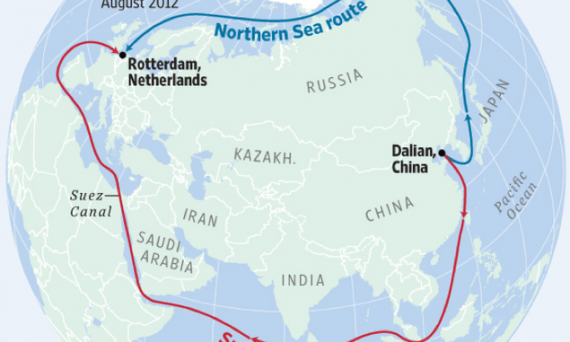This is a new joint project by Tyumen State University and European University at Saint-Petersburg planned for 2017–2019 and funded by the Russian Ministry of Education and Science.
Background
NSR is a transport route along the Arctic coastline of Russia that connects Atlantic and Pacific oceans. In comparison with the southern route it is regarded as economically advantageous. Successful usage of NSR depends on climate conditions in the region. The round-the-year shipping traffic requires icebreakers and an elaborate backup infrastructure which today does not exist.
The idea of developing NSR is one of Russia’s new «national ideas», part of the governmental discourse “to reclaim the Artic”. The prospects of NSR were discussed during annual Forums of Polar Association (ASPOL). In his public address to the Federal Assembly (2015) President Putin called NSR a primary «link between Europe and Asian-Pacific region» that must be developed. The necessity of investing into NSR development is constantly emphasized by the government.
Navigation in Eurasian coastal areas of Arctic Ocean is documented at least since the 16th century but it was only in the 1930-s that it became possible to complete the trip through NSR within one navigation season. NSR development required various services embedded in local infrastructure, such as seaports, bases of polar aviation, meteorological stations and small coal factories. For this purpose, NSR management often had to establish new settlements to support sea ports and recruit workers or experts from non-Arctic regions.
In 1990-s the NSR traffic declined, parallel to the general economic crisis in the country and the outmigration from the region. According to recent official reports the cargo shipping is now rising again. NSR is now used by industrial companies, such as Norilsk Nickel , to provide the Arctic coast towns with necessary goods.
Some major changes that contribute to NSR reconstruction have already taken place: several centers for rescue service in the coastal area were established under the control of the Ministry for Civil Defense, Emergencies and Natural Disasters; military forces once again occupy the islands and archipelagos located in the Arctic seas; at least one platform for offshore oil extraction is in permanent operation in the Pechora sea; and a plant for liquefied gas production is working on the Yamal peninsula. Arctic tourism is also developing.
Outline of the project
The aim of the project is to document the current socio-economical state of seaport towns in order to create a starting point for investigating changes brought by future intensification of NSR traffic. In the absence of such intensification, the project will explore the interplay between the imagined «national» traffic lane and the real situation of the seaport system.
Different practices of imagining NSR constitute a major research focus of the project: the focus is on the structure of NSR imaginary (Steinberg, Tasch, Gerhardt 2015), both in historical and synchronic dimensions, which is shaped by concepts of space (NSR as a specific locality), and that of a transport system.
The project consists of two parts: an archival/historical and a fieldwork/anthropological ones, and focuses on the history of invention and contemporary social life of the Northern Sea Route (NSR).
The archival part of the project will analyze archival data and published sources in order to contribute to the historiography of NSR seaports; it will also explore the concept of NSR through the lens of historical geography. The NSR imaginary will be treated as a product of geographical imagination that now shapes both the official government discourse of “reclaiming the Arctic” and practices or ideas of local communities.
The fieldwork program includes description of current seaport infrastructures and, most importantly, anthropological research of seaport-towns’ communities including ethnographic description of current economic situation, sources of income, subsistence economy and official employment and local infrastructure.
The Team and Geography
The team consists of three researchers from Tyumen’ State University and seven from European University, St Petersburg. The team includes historians and anthropologists, early-career and experienced scholars, Ph.D. students and professors. The team will work on NSR all the way between Murmansk in the west and Petropavlovsk-Kamchatskii in the far east, which means visiting ten seaport towns and cities: Murmansk, Archangelsk, Indiga, Sabetta, Dikson, Khatanga, Tiksi, Pevek, Anadyr’, Providenia and Petropavlovsk-Kamchatskii.
Research questions
- When did the idea of NSR as a whole appear and for which historical period, discourse or community is it relevant?
- The structure of NSR imaginary: what patterns of geographical / infrastructural imagination form the perception of NSR by the local communities’ members?
- The types of seaport settlements: what similarities / differences can be traced between historical paths or post-Soviet transformation scenarios of NSR seaport towns?
- Social structure and identity of seaport towns’ communities: in what way do permanent dwellers of the town identify themselves.
- What are the expectations and fears of the supporting seaports communities?
Originally posted at Arctic Anthropology.
